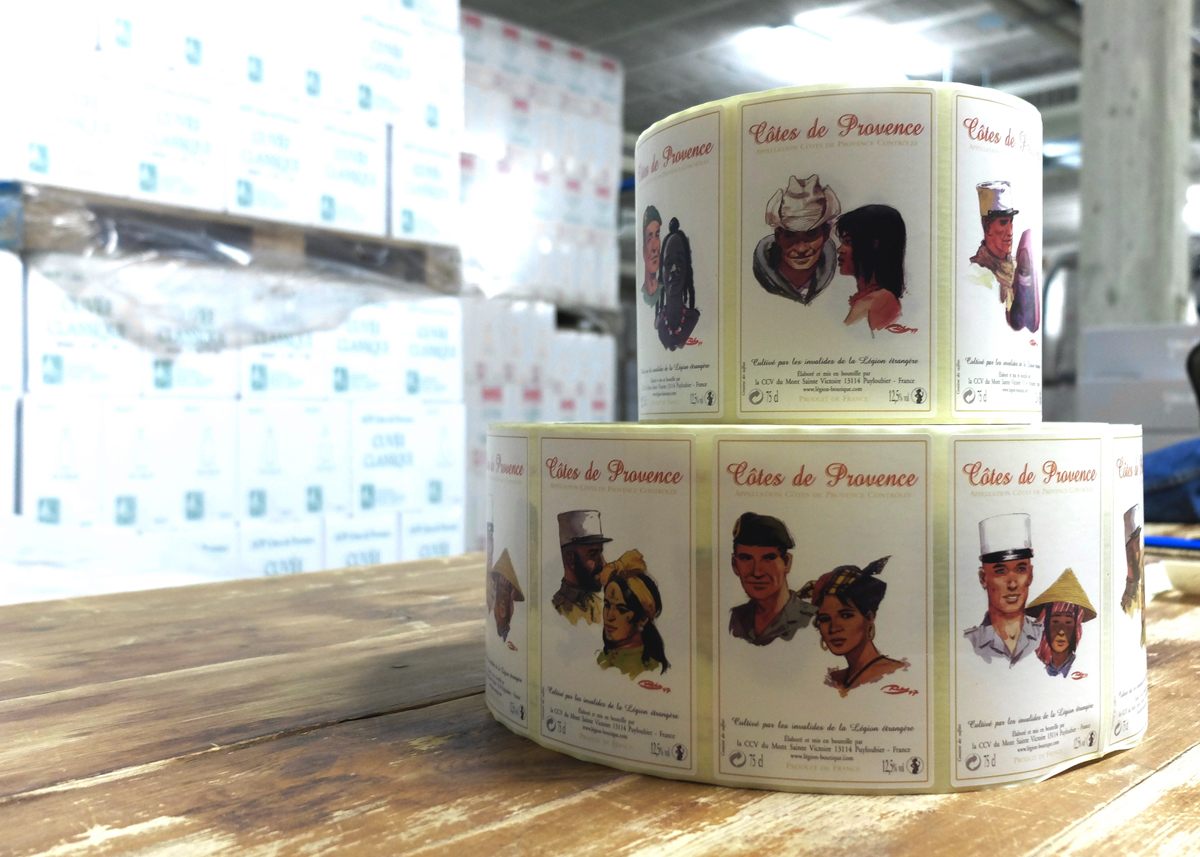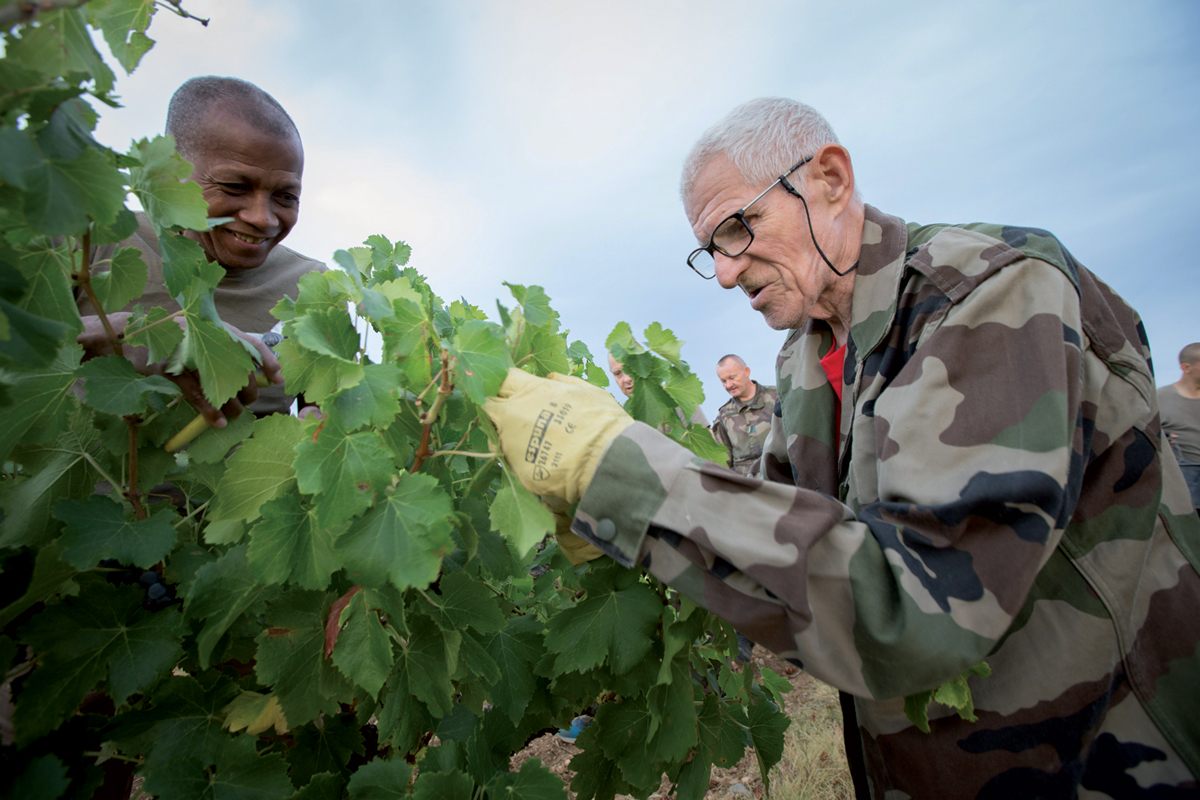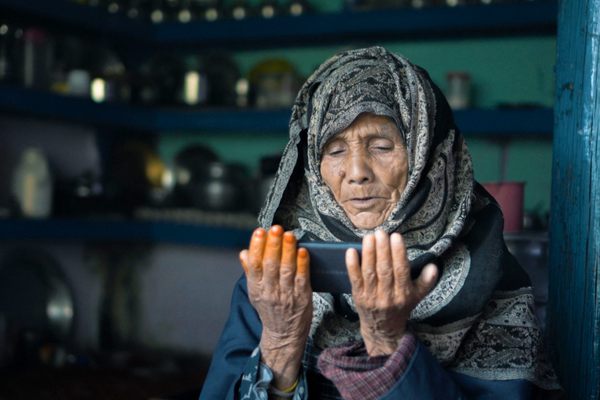The Vineyard Where Retired French Soldiers Make Wine
In Provence, Foreign Legion veterans report for duty among the vines.

“Tu n’abandonnes jamais les tiens, ni au combat, ni dans la vie.” These words grace the back label of Esprit de Corps Grand Cuvée, a Vermentino from Côtes de Provence Sainte–Victoire. It means, “You never abandon your own, not in combat, nor in life.”
The phrase references Article VII of the French Foreign Legion’s Code of Honor, which is a hint at the bottle’s unlikely provenance: a retirement home for former legionnaires. Nestled in postcard-perfect vineyards in Provence, the Domaine du Capitaine Danjou winery is the antithesis of abandonment. It provides lodging, purpose, and, most importantly, brotherhood. Leave it to the land of grands crus to properly care for its veterans through wine—sales of Esprit de Corps Grand Cuvée and other bottles help pay for the institution.
Set off the main road from the medieval village of Puyloubier, the Domaine has 100 acres of vines spread on gentle slopes around the estate. Along the Champs Elysees, the cheekily named path that extends between the vineyards, the Syrah vines are tidily trellised, stretching uniformly in straight rows. Further out, the Grenache grapes hang from gnarled, solitary bush vines. Armed with secateurs, men work with military precision, clipping off dead branches. The work is methodical, physical, and particularly challenging on days when the ferocious mistral wind whips through. But the men are undaunted; they belong, after all, to an elite military force.
“All their life they’ve been ordered around … go here, do that,” explains vineyard manager Adjutant-Chef Alan Lonjarret.

The French Foreign Legion has been a unique institution since King Louis-Philippe created it in 1831. Its initial composition of criminals and foreigners on the run—soldiers get a new identity and French citizenship in exchange for three years of service—fed its reputation as a rowdy band of mercenaries. Hardened by training and punishments, which included being tied to a wagon and dragged for falling behind on 40-kilometer marches, the soldiers were even brute in play: In the drinking game Buffalo, two men down a bottle of vermouth, then charge each other head on, resulting in severe concussions or death. The modern version of this notorious multi-national military cadre (soldiers hail from 150 countries, and 12% are French-born) is less savage, yet still embodies the fierce fraternité born from men leaving their homelands to pledge allegiance to the Legion.
How did the Legion go from battling enemies to bottling wine? In 1954, the First Indochina War left hundreds of young legionnaires injured. These soldiers, who were mostly German, Czech, and Hungarian, were too injured to return home, but in unfamiliar territory in France. In response, the Legion opened IILE, Institution des Invalides de la Légion Étrangère, to care for their brothers in need. They purchased a 17th-century chateau set beneath Sainte-Victoire, the stunning limestone mountain ridge made famous in Cezanne’s paintings. When they discovered the vineyards surrounding the sprawling estate were prime terroir, they stopped growing wheat and started making wine. The name, Domaine du Capitaine Danjou, comes from the revered officer who shared a bottle of wine with his soldiers before dying in the famed Battle of Camarón—a seminal event in the Legion’s history that is commemorated each year.

Today, the IILE lodges 74 pensionnaires between 32 and 99 years of age. They are here voluntarily, craving the camaraderie they enjoyed as legionnaires. “We are offering [the soldiers] eternity here, because you are already dead if no one thinks about you,” explains IILE’s new head, Lieutenant-Colonel Gilles Normand.
To live in wine country, a veteran must have completed his service with a good behavior certificate, be single, respect the rules of communal living, and participate in the center’s activities, which include bookbinding, ceramics, a uniform museum, and winemaking. These projects keep the soldiers’ brains and bodies busy while helping to fund the center—Lonjarret describes the life and work as occupational therapy.
Many countries’ veterans struggle to integrate back into civilian life and find purpose outside the military, but the problem is especially acute for legionnaires. Having shed their nationalities and left friends and family behind, foreign-born soldiers often base their identities on the Legion itself. Retirement means losing home, community, and employment all at once. In his article “The Hard Truth About the Foreign Legion,” Max Hastings writes about how legionnaires “find the rigors of service life less onerous than coping with the daily choices and decisions demanded of a civilian.” So while the IILE houses wounded veterans, the fields that fill with camo-wearing men picking grapes each harvest address the emotional and financial hardships that former legionnaires face.

Working in the vines is “a psychological wake up call,” says Alan Lonjarret, who is the veterans’ unofficial advisor and counselor. Toiling together in the vineyards is a salve for soldiers who suffer from loneliness or depression.
Corporal Alex—the retired legionnaires still address each other by rank—has worked the vines since his arrival 22 years ago. “When I was a kid in Bordeaux, I also got to harvest,” he says. Though his wild, white beard, weathered skin, and soft voice make him appear a decade older than his 68 years, he spends most mornings pruning, weeding, or harvesting grapes.
Clément, a fellow sexagenarian, is in his seventh year. (Official policy allows for the pensionnaires to only be identified by first name.) The hardworking Italian discovered the IILE 40 years ago—active-duty regiments arrive throughout the year to help the retirees with physically demanding tasks. Non-resident ex-soldiers also work at the winery, including 36-year veteran Jean Jacques Lalande, the chef du cave (cellar manager). Like the others, the slim 62-year-old had no wine experience. “Before I managed ammunition; now I oversee bottles and labels,” he says with a wink. Lalande enjoys his new post. “With work,” he says, “you leave behind loneliness.”

Though the Domaine has produced wine since the Legion’s arrival—the area’s wine history dates back to 600 B.C.—their oenological forays weren’t always successful. In 1962, only 25 of the 568 acres around the Domaine were planted with vines. The legionnaires sold the 32,000 bottles of wine to nearby regiments, but not to the public—it was as rough as pinard, the rustic red wine rationed to French soldiers in World War I. Realizing they didn’t have the know-how or the francs to make wine properly, the Legion began bringing their grapes to be vinified at the local cooperative, Vignerons de Mont Sainte-Victoire, in the 1980s.
In 2006, two volunteer oenologists from Bordeaux, Bertrand Leon and Philippe Baly, began consulting. Since their arrival, they have replaced low-yielding vines with more productive ones and moved the harvest date earlier to avoid overripe, overly alcoholic wines. With wine quality and production improving, the Legion was ready to give the public a taste. The winery commercialized in 2008.

That year also marked Lonjarret’s arrival. Having been born and raised in Bourgogne, the revered wine region, the appointment allowed him to resume a way of life interrupted by 30 years of military service. He continues his education on the job, managing the retirees and a staff of three tractor-machinists, two of whom are former legionnaires. He’s improved irrigation and upped the use of organic treatments, including manure sourced from the local cavalry unit. Like all winemakers, Lonjarret grumbles about paperwork, but enjoys his time amidst the vines and men. He likens the constant, physical work to military service. “If one doesn’t maintain a vine, it dies. With a soldier, it is the same.”
In 2017, 100 acres produced 220,000 bottles of wine, launching the legionnaires into the top five Sainte-Victoire producers. The soldiers preferred wine is red, and theirs is made from the classic Southern Rhone trio—Syrah, Grenache, and Mourvedre. The crisp whites come from 100 percent Rolle, also known as Vermentino. The rosé is a refreshing blend of Cinsault, Grenache, and Rolle—perfect for apèro hour. The area benefits from clay limestone soil that holds in the sun’s heat to keep the grapes warm at night, and the famous mistral wind dries the grapes, preventing disease naturally. According to specialists who test the soil annually, the Domaine has some of the region’s best terroir.

The cuvées labels capitalize on the mystique embedded in the Legion. On the Vin Classique, soldiers sport kepi blancs, the white toque worn during desert campaigns. A 1950s style pin-up girl flirts from the front of Miss Kepi Blanc rosé—she’s a caricature of the Legion’s annual pageant winner. The General Reserve, the first vintage to be aged in oak barrels, has an embossed bottle like those in nearby Châteauneuf-du-Pape; instead of the keys of St. Peter, there’s the Legion’s flaming grenade logo.
Wines run from 4.50 to 10 euros, save for the hefty 25-euro General. The bottles are shipped worldwide to former and active legionnaires, and are sold at bases, the IILE boutique, and online. “I just sent a shipment of vitamins to Lebanon,” Lalande jokes. The stockrooms empty out each year, which Lieutenant-Colonel Normand chalks up to the improved wine quality and the appeal of the Legion’s brand.

These best-selling bottles help clean up the negative connotations between the Legion and booze. The popular credo “legionnaires drink to forget, but they seldom forget to drink,” stems from binge-drinking bouts on foreign deployments and the strains of service that drive soldiers to self-medicate with alcohol. Normand says that in the current Legion, wine represents conviviality more than debauchery. It is the beverage of celebration and tradition, like the pour la poussière ceremony in which soldiers toast in unison before a meal, remembering troops serving in Africa who had to rinse desert dust (poussière) out of their glasses with wine when water was scarce.
At Domaine Capitaine Danjou, wine is the fuel that keeps the place and the veterans running. How fitting that foreigners who fought for France can spend their retirement engaging in the most French of traditions.
Gastro Obscura covers the world’s most wondrous food and drink.
Sign up for our regular newsletter.































Follow us on Twitter to get the latest on the world's hidden wonders.
Like us on Facebook to get the latest on the world's hidden wonders.
Follow us on Twitter Like us on Facebook